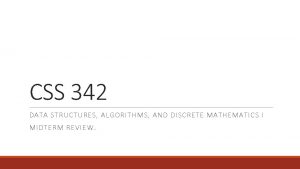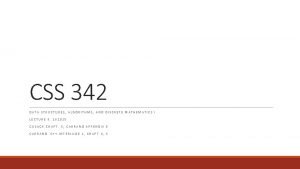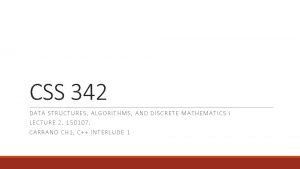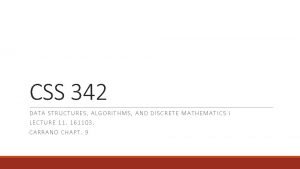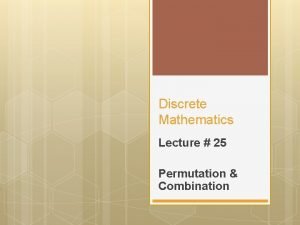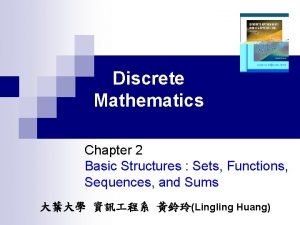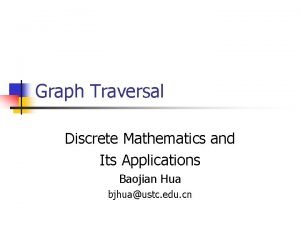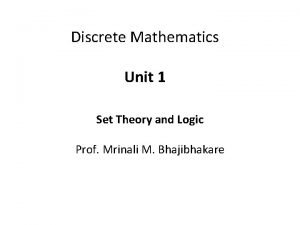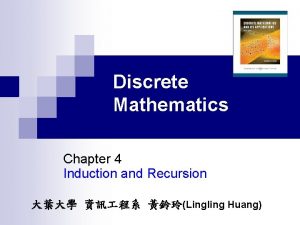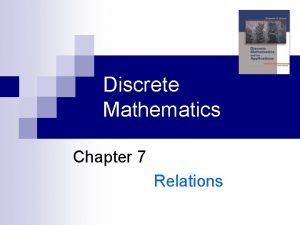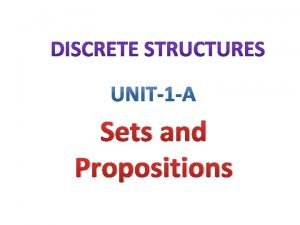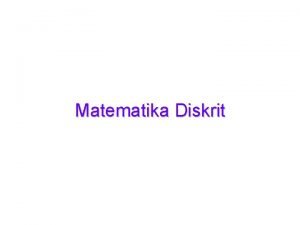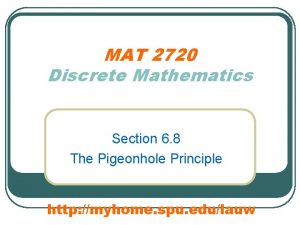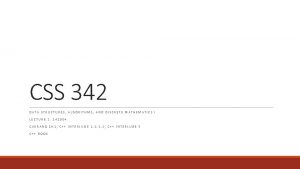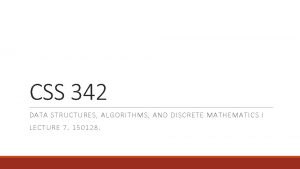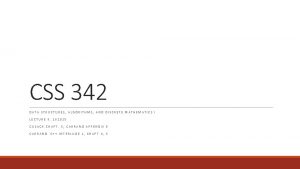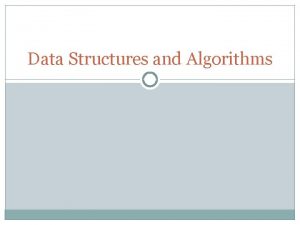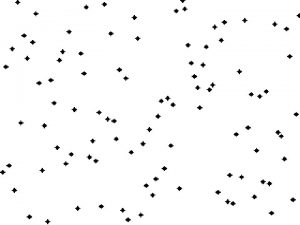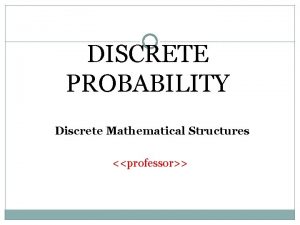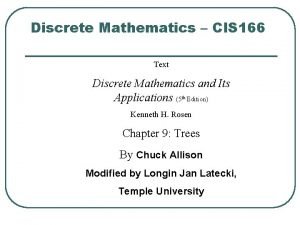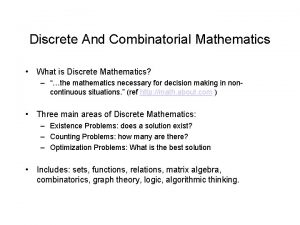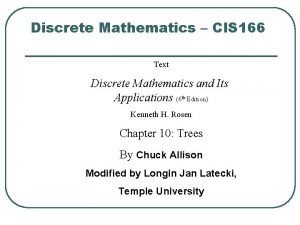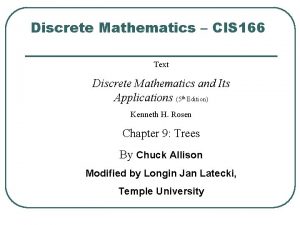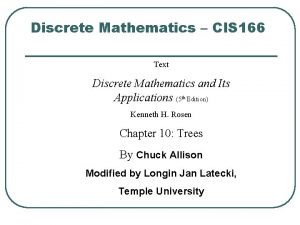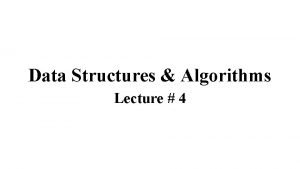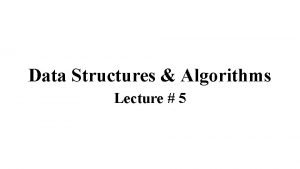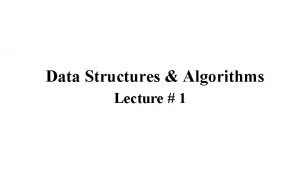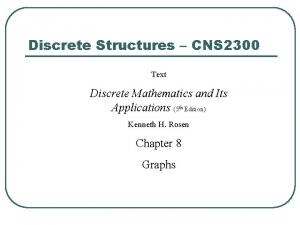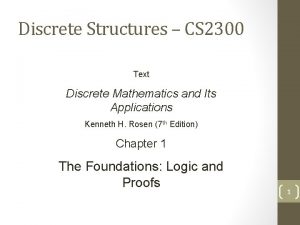CSS 342 DATA STRUCTURES ALGORITHMS AND DISCRETE MATHEMATICS


























- Slides: 26

CSS 342 DATA STRUCTURES, ALGORITHMS, AND DISCRETE MATHEMATICS I LECTURE 8. 161025 CUSACK CHAPT. 8, CARRANO APPENDIX E CARRANO C++ INTERLUDE 2, CHAPT 4, 6

Agenda • Announcements: Moving Mid. Term to Nov. 8 • In class pop quiz • Lab 3 Questions • Induction (First Half) • Linked List (Second Half)

In Class Code 1) Write a function which reverses the elements in an array. Input is the array and size of the array. 2) Do this in a way that does not use [ ] anywhere

Program 3 QUESTIONS

Induction 1; N -> N+1

Induction Axiom: The principle of mathematical induction A property P(n) that involves an integer n is true for all n ≥ 0 if the following are true: 1. P(0) is true. 2. If P(k) is true for any k ≥ 0, then P(k+1) is true.

Some history* *from our good friends at Wickapedia


n Proof by Induction for x Write a recursive function which calculates xn Prove the correctness of the recursive solution using induction int pow(int x, int n) { if (n == 0) return 1; else return x * pow(x, n-1); }

n Proof by Induction for x 1. Basis: 2. Inductive hypothesis: 3. 4. When n = 0, pow(x, 0) = 1. x 0 = 1. The recursive function is correct. When n = k, assume that pow(x, k) is correct, i. e. , xk. Inductive step: Show the pow(x, k+1) is correct. pow(x, k+1) = x * pow(x, k) By the inductive hypothesis, pow(x, k) returns the value xk. Thus, pow(x, k+1) = x * xk = xk+1 If pow(x, k) is correct, pow(x, k+1) is correct. Therefore, by the principle of mathematical induction, pow(x, n) is correct for any n ≥ 1.

Prove: a+ar 1+ar 2+ar 3+ … +arn =a(rn+1 – 1)/(r-1)

Where can I learn about induction? • Carrano, Appendix E • Cusack, Chapt. 8 • http: //courses. washington. edu/css 342/dimpsey/Program. Examples/Inductionv 4. pdf • https: //www. youtube. com/user/The. Mathsters (videos on induction)

Strong Form of Mathematical Induction A property P(n) that involves an integer n is true for all n ≥ 0 if the following are true: 1. 2. P(0) is true. If P(0), P(1), …, P(k) are true for any k ≥ 0, then P(k+1) is true. Difference from ordinary form of mathematical induction: P(k+1) is factorized in a combination of two or more of P(0) through to P(k). Proof by strong form of mathematical induction 1. 2. I. II. Base case or (basis): prove P(0) is true. Inductive step: Inductive hypothesis: Assume P(1), P(2), . . , P(k) is true for any k ≥ 0 Inductive conclusion: Prove P(k+1) is true.

Prove using induction: Every Integer > 1 Can Be Written as a Product of Prime Integers 1. Basis: n = 2. 2 is a prime number itself, and thus can be written as a product of prime integers. The proposition is true. 2. Strong Inductive hypothesis: Assume that the proposition is true for each of the integers 2, 3, … k 3. Inductive step: Show the proposition is true for k + 1. If k + 1 is a prime number, there is nothing more to show. If k + 1 is NOT a prime number, k + 1 is divisible and can be written k + 1= x * y where 1 < x < k + 1 and 1 < y < k + 1 Notice that x and y can be written as a product of prime integers by inductive hypothesis. If k is a product of prime numbers, k+1 is a product of prime numbers. Therefore, by the principle of mathematical induction, the proposition is true when n ≥ 1.

Computer Scientist of the week Anonymous Computer Scientist Hactivists Named 100 most influential people in the world (Time) Generally attack through DDOS Philosophy generally anarchic and swings between entertaining pranks or political activism • Strong support Occupy Movement and Arab Spring • Controversial methods • • “We [Anonymous] just happen to be a group of people on the internet who need—just kind of an outlet to do as we wish, that we wouldn't be able to do in regular society. . That's more or less the point of it. Do as you wish. . There's a common phrase: 'we are doing it for the lulz. ’”

Linked Lists “WE LIKE LISTS BECAUSE WE DON’T WANT TO DIE. ”, UMBERTO ECO

A node struct Node { string item; Node *next; } DATA STRUCTURES AND PROBLEM SOLVING WITH C++: WALLS AND MIRRORS, CARRANO AND HENRY, © 2013

A linked list FIGURE 4 -2 SEVERAL NODES LINKED TOGETHER Data Structures and Problem Solving with C++: Walls and Mirrors, Carrano and

A linked list with head. Ptr FIGURE 4 -3 A HEAD POINTER TO THE FIRST OF SEVERAL LINKED NODES Data Structures and Problem Solving with C++: Walls and Mirrors, Carrano and

Let’s build an Integer Stack • Use a linked list as a data structure • Use the following “node” structure struct Node { int value; Node *next; }; • Implement Push/Pop • Overload the following operators: • << • Assign = and Copy Constructor • +, +=

Push/Pop Implementation bool Int. Stack: : Push(int val) { Node *ins. Node; ins. Node = new Node; ins. Node->value = val; ins. Node->next = head; head = ins. Node; return true; } Int. Stack: : Int. Stack() { head = NULL; } Int. Stack: : ~Int. Stack() { this->Clear(); } bool Int. Stack: : Pop(int &val) { if (head == NULL) { return false; } else { Node *temp; temp = head; val = temp->value; head = head->next; delete temp; return true; } }

Proper stack clean up Int. Stack: : ~Int. Stack() { this->Clear(); } void Int. Stack: : Clear() { int a; while (Pop(a)); }

Let’s build an Integer Stack • Use a linked list as a data structure • Use the following “node” structure struct Node { int value; Node *next; }; • • Implement Push/Pop Overload the following operators: • << • Assign = and Copy Constructor • +, +=

Class Bell

Print Stack ostream& operator<<(ostream &out. Stream, const Int. Stack &stack) { Node *p. Node; p. Node = stack. head; while (p. Node != NULL) { out. Stream << p. Node->value << endl; p. Node = p. Node->next; } return out. Stream; }

Let’s build an Integer Stack • Use a linked list as a data structure • Use the following “node” structure struct Node { int value; Node *next; }; • • Implement Push/Pop Overload the following operators: • << • Assign =, copy constructor • +, +=
 Css 342
Css 342 Css342 pdf
Css342 pdf Css 342
Css 342 Ctures
Ctures Data structures and algorithms iit bombay
Data structures and algorithms iit bombay Cos 423 princeton
Cos 423 princeton Data structures and algorithms tutorial
Data structures and algorithms tutorial Information retrieval data structures and algorithms
Information retrieval data structures and algorithms Data structures and algorithms bits pilani
Data structures and algorithms bits pilani Ajit diwan iitb
Ajit diwan iitb Data structures and algorithms
Data structures and algorithms Data structures and algorithms
Data structures and algorithms Waterloo data structures and algorithms
Waterloo data structures and algorithms Information retrieval data structures and algorithms
Information retrieval data structures and algorithms Data structures and algorithms
Data structures and algorithms Algorithms + data structures = programs
Algorithms + data structures = programs Permutation and combination in discrete mathematics
Permutation and combination in discrete mathematics Onto function definition
Onto function definition Bfs and dfs in discrete mathematics
Bfs and dfs in discrete mathematics Sets and propositions in discrete mathematics
Sets and propositions in discrete mathematics Induction and recursion discrete mathematics
Induction and recursion discrete mathematics Antisymmetric closure
Antisymmetric closure Sets and propositions in discrete mathematics
Sets and propositions in discrete mathematics Matematika diskrit kenneth rosen pdf
Matematika diskrit kenneth rosen pdf Pigeonhole principle in discrete mathematics
Pigeonhole principle in discrete mathematics Absorption law logic equivalence
Absorption law logic equivalence Equivalence statement definition
Equivalence statement definition
